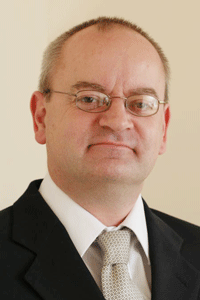As researchers work to understand nanotechnology impact on environment, USC studies have international prominence
June 11, 2013

Dr. Jamie Lead, director SmartState Center
for Environmental Nanoscience and Risk.
A study on nanoparticles and their toxicology, co-authored by Dr. Jamie Lead of the Arnold School of Public Health, calls for better defined criteria for understanding the possible toxicological impact on the environment. The report in the journal, Nature Nanotechnology, is just one in a series of achievements that highlight the caliber of nanoscience research being conducted at the SmartState Center for Environmental Nanoscience and Risk (CENR) at the University of South Carolina.
Earlier this year, Lead and Dr. Stephen Holgate of the University of Southampton, UK, had another report in Nature Nanotechnology, titled “Regulatory and Research Needs,” highlighting the discussion needed for reporting standards of nanotoxicological in both fundamental and applied research.
“Implementing consistent standards is broader than simply reporting appropriate physical and chemical characterization; it starts with problem formulation and hypothesis generation,” Lead and Holgate wrote. “At its broadest level, procurement of nanomaterials and their characterization can be differentiated for regulatory and research purposes. For regulatory purposes, the standards applied and data generation required must be more prescriptive, whereas for research these must be primarily based on the hypothesis to be tested.”
Lead was additionally co-author on another paper, “Transformation of Nanomaterials in the Environment,” published in the journal Environmental Science and Technology last year. The journal named the paper the “Best Feature Article 2012.” (Related article this page.)
The new report, “Nanoparticle Dispersity in Toxicology,” is a definitive survey of studies on the ecotoxicology of nanoparticles to determine how nanoparticle size and size distribution are reported. The goal was to better understand the physical and chemical characteristics of nanoparticles and the impact, if any, that these properties might have on toxicity.
Lead is a faculty member in the Arnold School’s Department of Environmental Health Sciences. His co-author Dr. Mohammad Baalousha is currently at the University of Birmingham in the United Kingdom, but has recently been appointed to a tenure track position in the CENR, starting January 2014. Their joint report said that more than 75 percent of the studies did not report on the size and size distribution of nanoparticles. “Under 25 percent of the studies reported this information. Of those that did, almost all had very wide size distributions, making it difficult to understand the impact of this fundamental parameter on toxicity”.
Some studies have suggested that nanoparticles may have size-dependent toxicity.
They compared the way that nanoparticle size is reported in the nanotoxicology literature and then compared those findings with criteria established by the U.S. National Institute of Standards and Technology (NIST) and elsewhere on monodispersity, which is characterized by particles of uniform size in a dispersed phase.
“To better understand the role of their size, nanoparticles should be made more monodisperse, and their reporting must be improved in all toxicological studies,” he said.
The fact that little information is available in the scientific literature came as little surprise to the researchers. The study of environmental nanoscience and nanoecotoxicology as a “stand alone field” is very new, said Lead.
“Our review is a reflection of the early stages of study, and our work is intended to move this field of science forward in a responsible way,” he said. “We want to protect environmental and human health, while receiving the benefits of nanoscience.”
Since arriving at USC last fall, Lead has worked to develop the CENR while continuing his research program, begun in the United Kingdom. He is in the process of hiring researchers for the center, a collaboration between the Arnold School and the College of Arts and Sciences’ Nano Center. The center is part of the SmartState Program,™ established by the S.C. General Assembly with funds from the S.C. Education Lottery, to encourage economic development in the Palmetto State.
Lead was also a featured speaker in January for the TEDxColumbiaSC, featuring speakers who are committed to promoting “Ideas Worth Sharing.” To know more about the TEDxColumbiaSC program, visit http://www.tedxcolumbiasc.com.
To read the Nature Nanotechnology report (May 2013) by Lead and Baalousha, visit http://www.nature.com/nnano/journal/v8/n5/index.html.
To read the Nature Nanotechnology report by Lead and Holgate (February 2013), visit http://www.nature.com/nnano/journal/v8/n2/index.html.



_01.jpg)
_02.jpg)